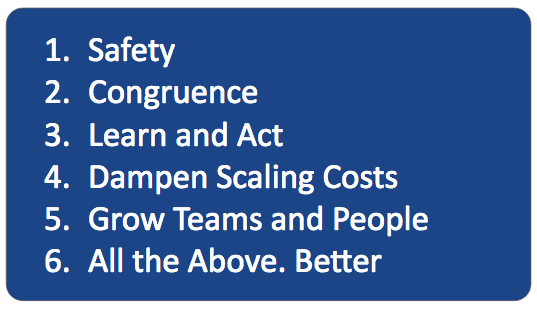Do the work…
There’s no silver bullet: continuous improvement takes resources and work, humility, empathy, and teaming. It is less about the methodology you pick (across hundreds of templates and books you’ll find remarkably similar themes these days) and more about the work you do, and the degree to which you can reflect on the meta-process of improving how you improve.
Which means we need to heed Steven Pressfield’s advice and Do The Work.
Give it a try!
Below you’ll find 6 questions that I have found particularly useful for guiding continuous improvement efforts. Gather a cross-section from your team — mixed seniority and functional areas — and have a conversation about these questions. Of course, you’ll need safety (see question 1) to have the conversation (see question 6), but maybe that is your starting point. That’s your first hurdle. You have to start somewhere.
See the Notes section for some commentary on these questions
How effective are we at:
- Maintaining a safe and healthy environment for individuals and teams?
- Resolving areas of widespread cognitive dissonance?
- Learning and converting our learnings into customer value?
- Dampening the negative impacts of scaling and growth?
- Helping our people and teams grow?
- Sensing changes to, and continuously improving on the the areas above?

Talk about it. What have you observed? What is the delta since you last spoke? How do your individual biases impact your perception of what you have observed? Are you hearing all voices? Are you missing data? Where are the opportunities for improvement? What would happen if you did nothing? Might certain things just work themselves out?
One of my mentors wisely cautioned:
Fight the temptation to see continuous improvement as a conduit for your pet projects and career advancement. It’s tempting. One of the biggest blockers to change is the desire to take credit for it.Set a “Change In Progress” limit and prioritize safe-to-fail experiments. Too much change or change that is too prescriptive is the enemy of successful evolution. Stop starting and start finishing. Consider a continuous improvement Kanban board detailing ongoing efforts. Rinse and repeat. As David Snowden writes:
Instructive patterns can emerge if the leader conducts experiments that are safe to fail. That is why, instead of attempting to impose a course of action, leaders must patiently allow the path forward to reveal itself. They need to probe first, then sense, and then respond.This requires a certain level of introspection and humility. What if a leader is contributing to the problem? At the root of cognitive dissonance (2) we often find friction between leaders which manifests in unclear objectives and unnecessary tension. To see our own failings more clearly it may be necessary to cast a wider net for data (e.g. engagement surveys, 360 and peer reviews, etc.) Leaders are, in that regard, team members. It is Team with a capital “T”.
Notes
- Safe environments welcome diversity, risk taking, experimentation, dissent, and sharing difficult feedback. Individuals can be authentic. Unsafe environments do this selectively, or not at all
- Examples might include the acceptance of toxic behavior from an individual, inability to respond to a growing threat, or situation where teams/individuals have accepted a way of working that is hurtful/unhealthy to others. It is widespread in the sense that has reached “watercooler status” or a frequent topic of 1:1 so-called scuttlebutt
- Context and data can inform a team, but it does not in itself produce positive outcomes. You’re marrying two competencies — to Sense and Respond
- Examples of negative effects attributable to scaling and growth include accumulation of technical debt, UX debt, increased dependencies, hardening silos, decreased speed and agility, decreased information flow, disengaged teams, premature optimization, etc. Many of these “costs” are invisible and difficult to quantity which complicates the issue.
- Importantly, this can sometimes involve individuals “growing out” of the organization. One could argue that for the benefit of the company you’d like to see a shared growth goal that benefits company / individual, but I’ve found this to be unrealistic and counterproductive expectation (and profoundly immune to intervention).
- Continuous improvement involves regular discussion, action, and reflection. Are you addressing the right questions? Are your conversations safe? Are you gathering all available data?